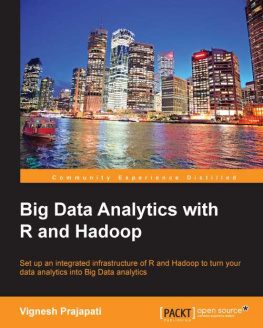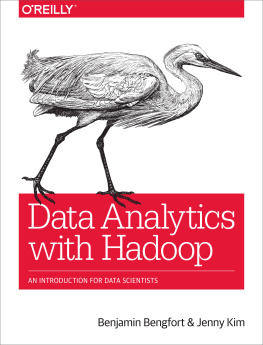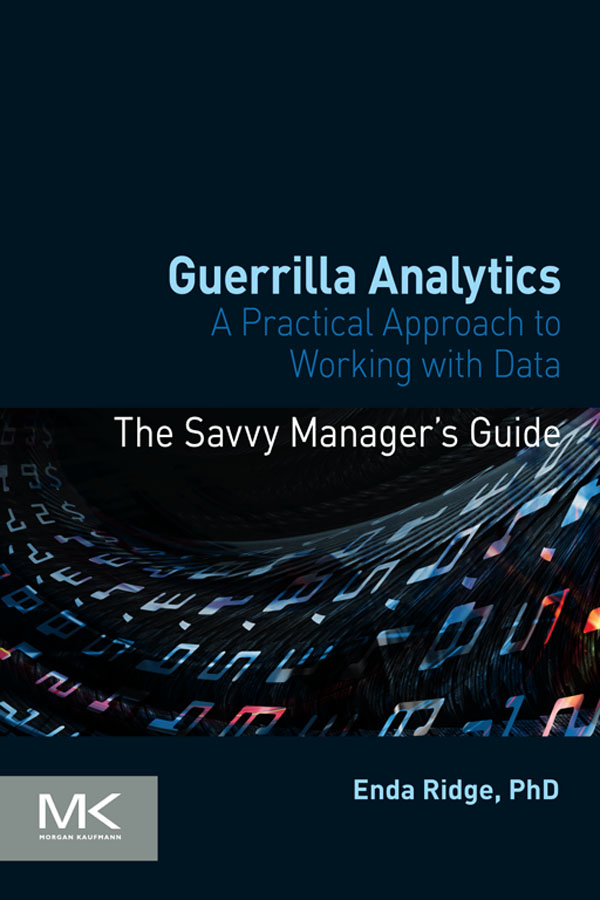Copyright Page
Acquiring Editor: Steve Elliot
Editorial Project Manager: Kaitlin Herbert
Project Manager: Priya Kumaraguruparan
Designer: Mark Rogers
Morgan Kaufmann is an imprint of Elsevier
225 Wyman Street, Waltham, MA 02451, USA
Copyright 2015 Enda Ridge Published by Elsevier Inc. All rights reserved
No part of this publication may be reproduced or transmitted in any form or by any means, electronic or mechanical, including photocopying, recording, or any information storage and retrieval system, without permission in writing from the publisher. Details on how to seek permission, further information about the Publishers permissions policies and our arrangements with organizations such as the Copyright Clearance Center and the Copyright Licensing Agency, can be found at our website: www.elsevier.com/permissions.
This book and the individual contributions contained in it are protected under copyright by the Publisher (other than as may be noted herein).
Notice
Knowledge and best practice in this field are constantly changing. As new research and experience broaden our understanding, changes in research methods, professional practices, or medical treatment may become necessary.
Practitioners and researchers must always rely on their own experience and knowledge in evaluating and using any information, methods, compounds, or experiments described herein. In using such information or methods they should be mindful of their own safety and the safety of others, including parties for whom they have a professional responsibility.
To the fullest extent of the law, neither the Publisher nor the authors, contributors, or editors, assume any liability for any injury and/or damage to persons or property as a matter of products liability, negligence or otherwise, or from any use or operation of any methods, products, instructions, or ideas contained in the material herein.
British Library Cataloguing-in-Publication Data
A catalogue record for this book is available from the British Library
Library of Congress Cataloging-in-Publication Data
Application submitted
ISBN: 978-0-12-800218-6
For information on all MK publications visit our website at http://www.mkp.com
Preface
Why this book?
Data analytics involves taking some data and exploring and testing it to produce insights. You can put a variety of names on this process from Business Intelligence to Data Science but fundamentally the approach does not change. Understand a problem, identify the right data, prepare the data appropriately, and run the appropriate analysis on it to find insights and report on them. This is difficult. You are probably seeing this data for the first time. Worse still, the data usually has issues you will only uncover during your journey. Meanwhile, the problem domain must be understood so the data that represents it can be understood. But what is discovered in the data often helps define the problem domain itself.
Faced with this open-ended challenge, many analysts become lost in the data. They explore multiple lines of enquiry. One line of enquiry can invalidate or confirm a previous line. The structure and exceptions in the data are discovered during the process and must be accounted for. Many of the analyses themselves can be executed in a multitude of ways, none of which are categorically correct but instead must be interpreted and justified. Just when you thought you had a handle on the problem, new data arrives and everything you have already done is potentially invalidated. This makes planning, executing, and reproducing data analytics challenging.
If you have ever been in this situation then this book is for you.
What this book is and what it is not
First of all, let me cover what this book is not.
This book is not a prescriptive guide to either specific technologies or analytics techniques. For that you will have to read widely in fields such as machine learning, statistics, database programming, scripting, web development, and data visualization. It is my belief that while technology continues to improve at pace, the fundamental principles of how to do data analytics change little.
This is not a project management book. I certainly believe project management of analytics needs more attention. Analytics projects are complex and fast-paced and it seems that established project management techniques can struggle to cope with them. This book will help you in areas such as tracking of work but it does not take a project management focus in the presentation of any of its material.
This book is not about Big Data. It is also not about little data or medium data. Debates about whether Big Data is something new or indeed something at all are left to others. As you will see, this books principles and its practice tips are applicable to all types of data analysis regardless of the scale.
This book is not about how to build large data warehouses and web-based Business Intelligence platforms. These techniques are also well covered in the literature having been tackled in academia and the software development industry for several decades.
My goal in writing this book is to help people who have been in the same situation as me. I want them to benefit from my experiences and the lessons I have learned, very often the hard way. This book aims to help you in the following three ways.
How to do: This book is a guiding reference for data analysts who must work in dynamic analytics projects. It will help them do high-quality work that is reproducible and testable despite the many disruptions in their project environment and the typically open-ended nature of analytics. It will guide them through each stage of a data analytics job with overarching principles and specific practice tips.
How to manage: This book is a how-to for data analytics managers. It will help them put in place light weight workflows and team conventions that are easy to understand and implement. Teams managed with this books principles in mind will avoid many of the pain points of analytics. They will be well coordinated, their work will be easily reviewed and their knowledge will be easily shared. The team will become safely independent, freeing up the manager to communicate and sell the teams work instead of being mired in trying to cover every detail of the teams activities.
How to build: Finally, this book is a guide for those with the strategic remit of building and growing an analytics team. Chapters describe the people, processes, and technology that need to be put in place to grow an agile and versatile analytics team.
Who should read this book?














